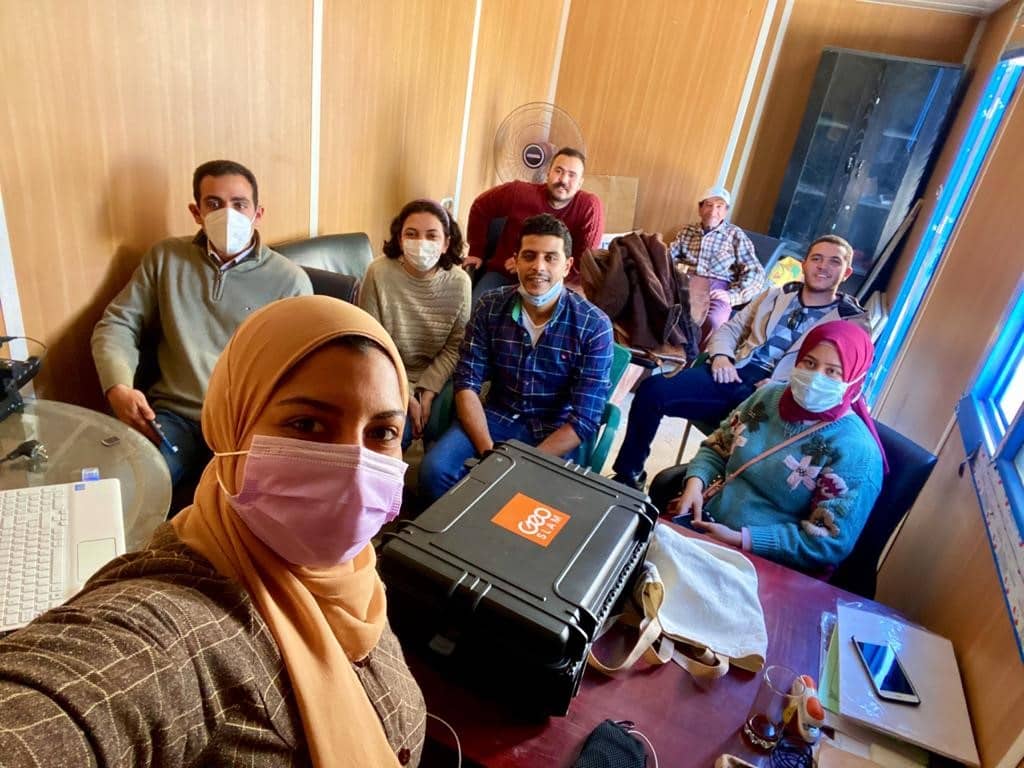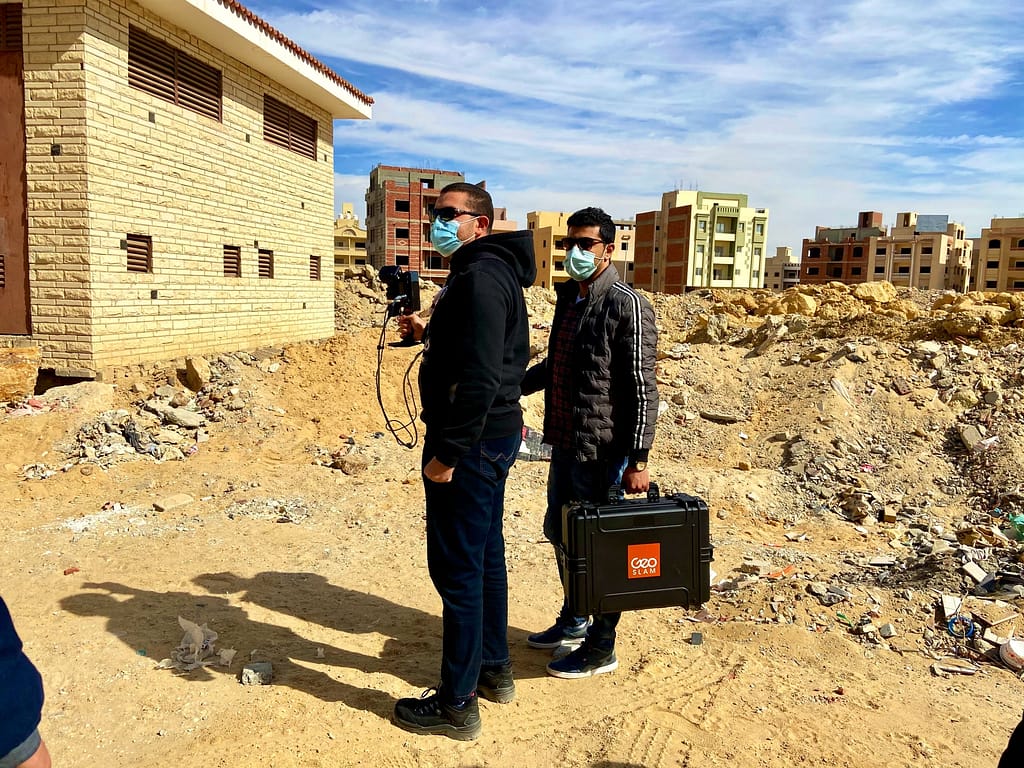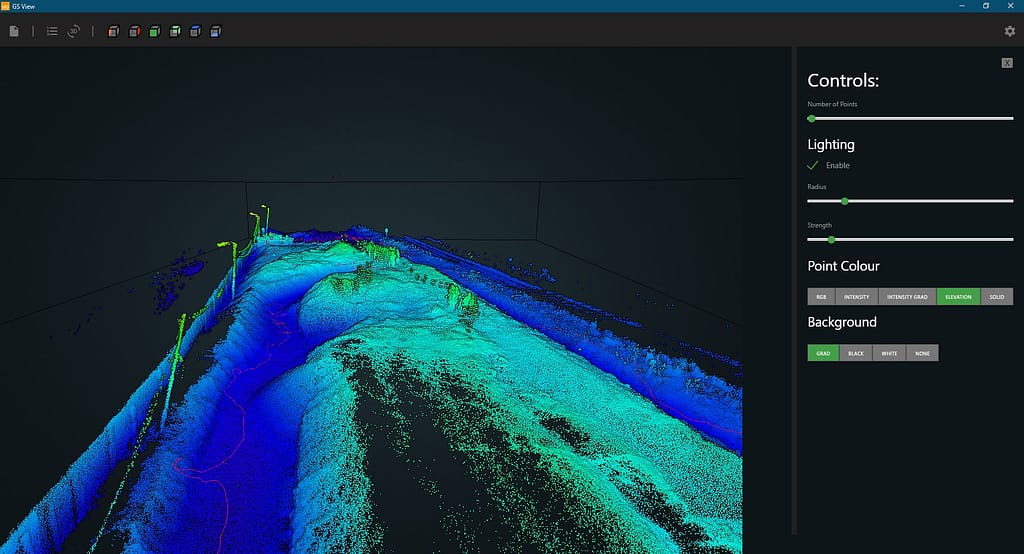Generating efficient construction site surveys with mobile LiDAR
Last Updated on 28th July 2023 Generating efficient construction site surveys with… Read More »Generating efficient construction site surveys with mobile LiDAR
Last Updated on 28th July 2023 Generating efficient construction site surveys with… Read More »Generating efficient construction site surveys with mobile LiDAR
Last Updated on 7th October 2022 The benefits of BIM and Scan… Read More »The benefits of BIM and Scan to BIM
ZEB Revo RT | Housing and Building National Research Centre
The government of Egypt (GoE) are leading several initiatives to reuse and recycle the ever-increasing quantities of construction and demolition Waste (CDW) around the country. These initiatives include a national strategy and action plan to effectively manage around 40 million tons of CDW generated annually. They target to recycle 50% of CDW materials by 2030. One of the major challenges facing Municipalities in Egypt is calculating the amount of CDW accumulated, due to illegal dumping of waste being common place in cities.
Commissioned by the Ministry of Environment and the GIZ institution, HBRC (Housing and Building National Research Centre) have been tasked with finding effective methods for quantifying and characterising the amount of CDW in four Egyptian Governorates (Gharbia, Kafr-El-Sheikh, Assuit and Qena).
This project paves the way to developing an optimal construction and demolition waste management strategy in Egypt. The research team used GeoSLAM’s ZEB Revo RT SLAM laser scanner to map the construction waste piles. The scan data is a sound method for quantifying waste volumes over a period of time, due to the ease of capture and accurate data.
The traditional surveying of CDW accumulations was not practical as CDW locations are difficult to walk through and experience rapid changes to the waste quantities.
The ZEB Revo RT is ideal for rapid data capture in real time, making it the perfect tool for this job. By walking through the construction and demolition waste sites, the team are mapping as they go, shortening the amount of time spent in a hazardous environment, reducing health and safety risks.
The simplicity of the solution means that anybody can capture the data, with minimal training, making the scans repeatable as often as needed. Covering an area of 84,823 m2, the research team conducted 12 scans, dividing the route into zones and each scan lasted an average of 17 minutes.
Once the scanning was complete, they opened the data in GeoSLAM Hub where the point cloud can be viewed and prepared for GeoSLAM Volumes. Using GeoSLAM Volumes, the researchers could accurately calculate the quantity of construction and demolition waste. The findings were reported back in a presentation during the third International conference on Smart Cities.
This way of calculating volumes is fast, efficient, cost effective, safer than other methods and repeatable, making the SLAM scanner the right tool for the job. The research effort opens the door into the utilisation of 3D modelling of construction waste management sites.
The application of laser technology would enable the quick and accurate estimation and modeling of waste quantities.



If you’d like to learn more about how GeoSLAM solutions can help you, submit the form below.
Control points are points within a given area that have known coordinates. They are a key tool in the geospatial industry and can be utilised in a variety of ways, including georeferencing point clouds and aligning aerial images to terrestrial data. By using control points, surveyors are able to accurately map larger areas and position overlapping surveys of an area together. They can also be used in non-geospatial industries, such as construction and mining, to show clear temporal comparisons between multiple surveys of the same area. This method of georeferencing is also referred to as adjust to control.
Previously, checkerboards and spherical targets have been used as control markers – these items are captured in surveys and can be identified for georeferencing or aligning. The main drawback with these methods is that they rely heavily on human interpretation when processing, meaning that the processed datasets may be susceptible to an increased amount of error.
When capturing handheld surveys, GeoSLAM systems are able to collect reference points. These can then be matched with known control points to reference scans and increase the level of accuracy.
Easily reference point clouds and produce reports highlighting accuracy values.
Regularly monitor site operations (e.g. stockpiles) and hazards.
Compare changes over time and map progress onto predetermined CAD/BIM models.
Once georeferenced using control points, point clouds can be optimised further using leading third party software:
For more information about our third party partnerships, head to our integrations page.
Keep up to date with the latest news and thought leadership from GeoSLAM.
With increasing awareness of LiDAR technology, its applications are becoming more diverse….
Popular Nottingham bar as you’ve never seen it before A historic chapel,…
Using 3D laser scanning to map difficult environments The advances in handheld…
Location: United Kingdom
ZEB Scanner: ZEB Horizon
Scan time: 45 Minutes
Would you like to see a specific dataset that’s not on this page? Contact [email protected]
GeoSLAM were invited by Willmott Dixon to be involved with the beginning of this process, by scanning the existing used timber units provided by Carter Accommodation. Using the ZEB Revo RT, Willmott Dixon were able to capture data of all 4 cabins, in 4 minutes, registering over 8 million number of points.
As the adoption of SLAM rockets, and new applications for mobile data capture are discovered each day the value of SLAM is being proven across businesses of all shapes and sizes. GeoSLAM technology continues to break barriers and the ever-increasing profile of SLAM users grows each day.
Why firms need to double down
Innovation in construction gets a bad rap. Which feels somewhat unfair, after all, it is a ‘bricks and mortar’ industry, heavily reliant on equipment, machinery and a ‘hands-on’ workforce. The industry is often flouted as falling behind others in how it has embraced technology. Yet in recent years in particular, many forward-looking construction companies have deployed innovative solutions to better, and more safely, construct buildings.
But few companies have captured the full benefit of digital, and some have questioned whether they have the right approach. Piloting is one-thing, getting company-wide adoption is another. And it’s not hard to see why. As construction projects are typically fragmented, there are a number of hurdles for companies to overcome:
According to the Future of Construction, Building Information Modelling (BIM) is the centre piece of the construction industry’s digital transformation. Over the last decade BIM awareness and adoption has grown from little more than 10% in 2011 to over 70% in 2020. And the benefits speak for themselves: NBS reports that adopters report greater predictability of building performance, price and programme; as well as reduced risk and increased profitability.
Yet while BIM standards are becoming embedded, and thankfully fewer people see BIM simply as ‘3D modelling’, there is still work to narrow the gulf between ‘BIM engaged’ and ‘BIM laggards’. Deploying cutting-edge technology is only one aspect. Having the mindset and approach to collaborate is what will really unlock the value of the tech.
At the core of BIM success is collaboration. In fact, you can’t really ‘do’ BIM if you don’t have the entire team on board in the earliest stages.
NBS
Aside from BIM, there are a number of connected construction technologies that are being adopted to streamline and ease the process of constructing our built world. But given the array of new technologies on offer, where’s the best place to start?
When the pandemic hit in 2020, and ‘working from home’ just became ‘working’, we all realised the difficulties in communicating and collaborating with remote teams. Add to that the challenge construction professionals already had of multi-layered teams, and it’s easy to see where the friction could be.
What makes construction complex is not the complexity of the building, it’s the number of people that are required to work together to make it happen.
Nathan Wood, Executive Director, Construction Progress Coalition
While it’s tempting to cherry-pick solutions that fix a particular problem, developing narrow use cases may mean missing out on the wider opportunity. But by taking a collaboration-first approach and starting with technology that improves knowledge-sharing, smooths interactions and boosts interoperability, this could have significant knock-on effects to address other challenges, too.
For example, selecting tech that has the potential to integrate well with all other platforms means you’re not facing digital isolation. And by putting data transparency and data collection first by choosing tools that create 3D maps, this data can in turn, be used as the anchor for better decisions between all parties. And in unlocking collaboration barriers, this could be the key to creating lasting value.
In ‘Decoding Digital Transformation in Construction’ McKinsey & Co., cites how one collaboration tool drove down rework costs for a leading contractor. The quoted example talks about the contractor’s process for collecting comments on defects found onsite. Workers typically provided anecdotal, unstructured or difficult to act on feedback, which resulted in unplanned rework and delays.
This radically turned around when the contractor introduced a digital app to tag defects against specific elements in the BIM model and store them in a common data environment. A simple but effective collaboration solution that on-site teams could easily adopt. It smoothed out communication plus reduced rework and improved the bottom line.
Companies that take a collaboration-first approach put themselves in a much stronger competitive position. Not only can they get first-mover advantage, but they can boost productivity at the same time as keeping costs down:
Construction has a long record of poor productivity and firms experience delays on a quarter of their projects, with nearly one fifth of projects going over budget. But with the wide adoption of mass data collection technologies, site workers can now carry out a weekly, or even daily, ‘as-built’ scan of a site which highlights any discrepancies or defects during the build. NBS research suggests that 3D modelling technology can deliver cost efficiencies (60%) and increase speed of delivery (55%).
With multiple stakeholders engaged at various points of the project lifecycle, having “one source of the truth” such as BIM, enables greater collaboration and more informed decision-making. Data is brought out of silos and there’s a consolidated view of all critical information, that everyone can see, in real-time. This improves workflow, predictability and removes bottlenecks. Critical to this is having a mapping tool that accurately captures the data in 3D model form and provides an anchor for all data extracts.
AI-powered solutions not only automate but accelerate non-value-add tasks across teams. This helps improve site efficiency and allows site workers to expand their capabilities. For example, on site, AI can provide real-time alerts in the event of safety violations, such as if PPE is not used at all times. And in the back office AI can easily reconcile budgets and billing by matching what happens on the ground to what’s been billed.
To be able to make better decisions faster, construction professionals need to know they’re confidently working with the most accurate data. A Common Data Exchange, such as the one being trailblazed by the Construction Progress Coalition will not only transform project collaboration but address the common data dilemma of getting the right info to the right people at the right time. It will also improve overall data integrity, data usage and make it easier to evidence compliance.
Being able to create an exact mirror of the asset in a digital twin, means you can spot and correct irregularities before building work starts, as well as monitor and correct defects on-site. This enables clients to mitigate some of the risk, time and cost impacts of complex construction projects. IDC predicts that companies that invest in digital twin technology improve cycle times of critical processes by 30%.
Royal BAM Group has a phrase that has become synonymous with the company which is, ‘We make it before we make it’. This digital-first approach enables the company to easily visualise the construction schedule, flag any potential problems and get back on track – while saving on rework.
This type of approach which aims to manage and share data between all key parties, is especially helpful when regenerating buildings or constructing new builds in busy cities. Aside from operating on constrained sites in busy locations (e.g., where the site footprint is the building footprint), sites are often live environments, with businesses in occupation. Staging construction offsite, or ‘just-in-time’ construction enables all stakeholders to virtually test the stress factors and tolerances of an asset in multiple ways, before the asset is built.
Wilmott Dixon is a privately-owned construction and interior fit-out specialist renowned for working on large and complex projects across the UK. To keep projects on-track, the contractor wanted to equip on-site teams with user-friendly mapping technology that could be quickly adopted and used by anyone. Scanners needed to be mobile, lightweight, and fast – and work in any weather. Mapping software needed to be automated, accurate and easy to interpret. GeoSLAM’s Construction Progress solution ticked all the boxes.
This innovative solution combines hardware, advanced SLAM and automated analytics for smart progress tracking. Site workers ‘walk-and-scan’ with a handheld SLAM scanner, and by simply plugging the scanner into a computer, the data is automatically processed using GeoSLAM’s smart data platform, Connect. This is digitally compared against the 3D model on record, and within minutes an automated report will show you the percentage of work complete/incomplete and a simple visualisation of the site, highlighting 3D changes.
The data is centrally stored providing a clear and reliable audit trail and remote teams can confidently share progress updates knowing they have a central source of the truth. Teams can continuously collect data as often as they need to, in some cases several times a day. The automated solution not only saves time and money but enables Wilmott Dixon to be on the front foot and proactively address any issues. It’s just one way the national contractor delivers lasting value.
Like many industries, the future of construction is firmly rooted in leveraging the benefits of digital technology to deliver better outcomes. While building sites will always be an organised chaos of physical, tangible assets, there’s still a huge opportunity for technology to transform the way buildings are constructed. But if you’re not getting the full value from digital technology alone, don’t give up. There is a better way.
Given the history of fragmentation and siloed working in construction, it follows that any, and every, digital innovation should seek to address this traditional way of working. And in doing so, will not only be a single-use case, but will have ripple effects across the whole value chain. Now really is the time to double down on digital efforts, collaboratively, of course.
Location: London, UK
ZEB Scanner: ZEB Horizon/ ZEB Discovery
Scan time: 20 Minutes
Colourised data was captured using the ZEB Discovery backpack solution.
Would you like to see a specific dataset that’s not on this page? Contact [email protected]
Location: United Kingdom
ZEB Scanner: ZEB Horizon
Scan time: 20 Minutes
This data was captured using GeoSLAM’s UAV Mount on a DJI drone and colourised using GeoSLAM’s ZEB Cam.
Would you like to see a specific dataset that’s not on this page? Contact [email protected]
Location: N/A
ZEB Scanner: ZEB Go
Scan time: 20 Minutes
Would you like to see a specific dataset that’s not on this page? Contact [email protected]